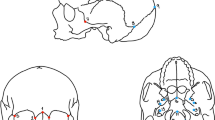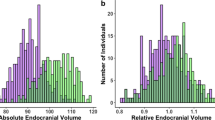Abstract
We have been checking the following working hypotheses: 1) There is a negative correlation between genetic heterozygosity and fluctuating asymmetry (FA); 2) FA is a measure of developmental stability/instability of the whole organism, i.e. we expect negative correlation between FA and morphological proximity of a set of mass-size variables of an individual to a population centroid; and 3) FA is a measure of character-specific stability in a population, i.e. we expect correlation between magnitude of FA and deviation of an individual from the population centroid of the bilateral characters themselves. For this purpose each individual in a sample of about 200 elderly individuals was assessed for 11 polymorphic blood systems (14 genetic loci) as well as for a set of 26 anthropometric traits: 1) a set of ten mass size variables; and 2) a set of eight pairs of bilateral measurements. Four multivariate measures of morphological centrality were computed, two measures for size and two measures of shape distances from the ith individual to the population centroid for mass-size variables and also for the bilateral variables. A multivariate measure of FA for 8 bilateral pairs was also computed. No relationship was detected between FA and heterozygosity, or between FA and any of the four multivariate deviations. Thus, we concluded that our data do not support the listed hypotheses.
Similar content being viewed by others
References
Anderson, T. W., 1984. An introduction to multivariate-statistical analysis. Wiley and Sons, New York.
Aschel, M. & M. Givon, 1982. Aging among survivors of the Holocaust. Gerontology 21–55: 55–65 (in Hebrew).
Bailit, H. L., P. L. Workman, J. D. Niswander & C. J. Maclean, 1970. Dental asymmetry as an indicator of genetic and environmental conditions in human populations. Human Biology 42: 626–638.
Blanco, G., J. A. Sanchez, E. Vazquez, E. Garcia & J. Rubio, 1990. Superior developmental stability of heterozygotes at enzyme loci in salmo salar L. Aquacul. 84: 199–209.
Clarke, G. M. & J. A. McKenzie, 1987. Developmental stability of insecticide-resistant phenotypes in blowfly: a result of canalizing natural selection. Nature 325: 345–346.
Clarke, G. M., B. P. Oldroyd & P. Hunt, 1992. The genetic basis of developmental stability in Apis mellifera: Heterozygosity versus genetic balance. Evol. 46: 753–762.
De Marinis, F., 1959. The nature of asymmetry and variability in the double bar-eyeless drosophila. Genet. 44: 1101–1111.
Dubrova, Yu. E., I. K. Dambueva, O. N. Kholod, V. D. Prokhorovskaya, E. I. Pushkina & M. L. Blank, 1991a. Influence of mother's heterozygosity on the variation of anthropometric traits in newborns. Genetika (USSR) 27: 2168–2176.
Dubrova, Yu. E., I. K. Dambueva, O. N. Kholod, V. D. Prokhorovskaya, E. I. Pushkina & M. L. Blank, 1991b. Influence of heterozygosity on the variation of anthropometric traits in newborns. Genetika (USSR) 27: 2157–2167.
Ferguson, M., 1986. Developmental stability of rainbow trout hybrids: Genomic coadaptation or heterozygosity. Evol. 40: 323–330.
Futuyma, D. J., 1986. Evolutionary biology. Sinauer associates, inc. Sunderland, Massachusetts.
Golan, R., J. Ben-Ezzer & A. Szeinberg, 1977. Esterase D polymorphism in several population groups in Israel. Hum. Hered. 27: 298–304.
Goldschmidt, R. B., 1955. Theoretical Genetics. Cambridge University Press, Berkeley (L.A.).
Graham, J. H. & J. D. Felley, 1985. Genomic coadaptation and developmental stability within introgressed populations of Enneacanthus gloriousus and E. obesus (Pisces, Centrarchidae). Evol. 39: 104–114.
Hartl, G. H., G. Lang, F. Klein & R. Willing, 1991. Relationship between allozymes, heterozygosity and morphological characters in red deer (Cervus Elaphus) and the influence of selective hunting on allele frequency distrubutions. Hered. 66: 343–350.
Jantz, R. L. & R. S. Webb, 1980. Dermatoglyphic asymmetry as a measure of canalization. Ann. Hum. Biol. 7: 489–493.
Jolicoeur, P., 1963. Bilateral symmetry and asymmetry in limb bones of Martes americana and man. Rev. Can. Biol., 22: 409–432.
Kartavtsev, Yu. F., 1990. Allozyme heterozygosity and morphological homeostatis in pink salmon Oncorhynchus gorbuscha (Pisces:Salmonidae). Genetika (USSR) 8: 1399–1407.
Kat, P. W., 1982. The relationship between heterozygosity for enzyme loci and developmental homeostasis in peripheral populations of aquatic bivalves (Unionidae). The Amer. Natur. 119: 824–832.
Kertzman, H., 1992. Anthropological and biochemical variables among industrial workers, suffering from hypertension and coronary heart disease. MS Thesis, Tel Aviv University.
Kobyliansky, E., S. Micle, M. Goldschmidt-Natan, B. Arensburg & H. Natan, 1982. Jewish population of the world: genetic likeness and differences. Ann. Hum. Biol. 9: 1–34.
Lahav, M. & A. Szeinberg, 1972. Rec-cell glutamic-pyruvic transminase polymorphism in several population groups in Israel. Hum. Hered. 22: 533–538.
Leary, R. F., F. W. Allendorf, K. L. Knudsen & G. H. Thorgaard, 1985. Heterozygosity and developmental stability in gynogenetic diploid and triploid rainbow trout. Hered. 54: 219–225.
Leary, R. F. & F. W. Allendorf, 1989. Fluctuating asymmetry as an indicator of stress: implication for conservation biology. Trends. Ecol. Evol. 4: 213–217.
Lerner, I. M., 1954. Genetic homeostasis. Oliver & Boyd, London.
Livshits, G. & E. Kobylianskyk, 1984. Biochemical heterozygosity as a predictor of developmental homeostasis in man. Ann. Hum. Genet. 48: 173–184.
Livshits, G. & E. Kobyliansky, 1985. Lerner's concept of developmental homeostasis and the problem of heterozygosity level in natural populations. Heredity 55: 341–353.
Livshits, G. & E. Kobyliansky, 1987. Dermatoglyphic traits as possible markers of developmental processes in humans. Am. J. Med. Genet. 26: 111–122.
Livshits, G. & E. Kobyliansky, 1989. Study of genetic variance in the fluctuating asymmetry of anthropometrical traits. Ann. Hum. Biol. 16: 121–129.
Livshits, G. & E. Kobyliansky, 1991. Fluctuating asymmetry as a possible measure of developmental homeostasis in humans. Hum. Biol. 63: 441–466.
Livshits, G., R. R. Sokal & E. Kobyliansky, 1991. Genetic affinities of Jewish populations. Am. J. Hum. Genet. 49: 131–146.
Livshits, G. & P. Smouse, 1993. Multivariate bilateral asymmetry in human adults. Hum. Biol. 65: 547–578.
Markow, T. A. & K. Wandler, 1986. Fluctuating dermatoglyphic asymmetry and the genetics of liability in schizophrenia. Psych. Res. 19: 323–328.
Markow, T. A. & J. P. Ricker, 1991. Developmental stability in hybrids between the sibling species pair, drosophila melanogaster and drosophila simulans. Genetica 84: 115–121.
Mather, K., 1953. Genetical control of stability in development. Hered. 7: 297–336.
Mellor, C. S., 1992. Dermatoglyphic evidence of fluctuating asymmetry in schizophrenia. Br. J. Psychiatry 160: 467–472.
Mitton, J. B., 1978. Relationship between heterozygosity for enzyme loci and variation of morphological characters in natural populations. Nature 273: 661–662.
Patterson, B. S. & J. L. Patton, 1990. Fluctuating asymmetry and allozymic heterozygosity among natural populations of pocket gophers (Thomomys Bottae). Biol. J. Linn. Soc. 40: 21–36.
Quattro, J. M. & R. C. Vrijenhoek, 1989. Fitness differences among remnant populations of the endangered sonoran topminnow. Science 245: 976–978.
Rasmusson, M., 1960. Frequency of morphological deviations as a criterion of developmental stability. Hereditas 46: 511–536.
Reeve, E. C. R., 1960. Some genetic tests on asymmetry of sternopleural chaeta number in drosophila. Genet. Res. 1: 151–172.
Smouse, P. E., 1986. The fitness consequences of multiple-locus heterozygosity under the multiplication overdominance and inbreeding depression models. Evolution 40: 946–957.
Soule, M. E., 1979. Heterozygosity and developmental stability: Another look. Evol. 33: 396–401.
Soule, M. E., 1982. Allomeric variation. 1: The theory and some consequences. Am. Nat. 120: 751–764.
Soule, M. E. & J. Cuzin-Roudy, 1982. Allomeric variation. 2: Developmental instability of extreme phenotypes. Am. Nat. 120: 765–786.
Szeinberg, A., S. Pipano, Z. Rozansky & N. Ravia, 1971. Frequency of red cell adenosine deaminase phenotypes in several population groups in Israel. Hum. Hered. 21: 357–361.
Szeinberg, A. & S. Tomashevsky-Tamir, 1971. Red cell adenylate kinase and phosphoglucomutase polymorphisms in several population groups in Israel. Hum. Hered. 21: 289–296.
Thoday, J. M., 1958. Homeostasis in a selection experiment. Hered. 12: 401–415.
Vazquez, E., G. Blanco, J. A. Sanchez, E. Garcia & J. Rubio, 1988. Relationship between biochemical heterozygosity and morphological variability in a stock of Salmos salar L. Rev. Biol. Univ. Oviedo 6: 3–15.
Vrijenhoek, R. C. & S. Lerman, 1982. Heterozygosity and developmental stability under sexual and asexual breeding systems. Evol. 36: 768–776.
Zakharov, V. M., 1981. Fluctuating asymmetry as an index of developmental homeostasis. Genetika (USSR) 13: 241–256.
Zakharov, V. M., 1987. Asymmetry of Animals. Nauka, Moscow.
Zink, R., M. Smith & J. L. Patton, 1985. Association between heterozygosity and morphological variance. J. Hered. 76: 415–420.
Author information
Authors and Affiliations
Rights and permissions
About this article
Cite this article
Livshits, G., Smouse, P.E. Relationship between fluctuating asymmetry, morphological modality and heterozygosity in an elderly Israeli population. Genetica 89, 155–166 (1993). https://doi.org/10.1007/BF02424511
Received:
Accepted:
Issue Date:
DOI: https://doi.org/10.1007/BF02424511




